He Knew George Washington! And Nathan Hale! And Alexander Hamilton!
Morris (Google Maps Location)
January 23, 2010
I often have recurring day-dreams of appearing on some “Connecticut Trivia” game show where they happen to ask picayune questions that only I know. After learning a lot about the unheralded town of Morris, one of those questions from my fictional host on my fictional game show is, “Name a town in Connecticut named after a Connecticut resident, and give the first and last name of that person.”
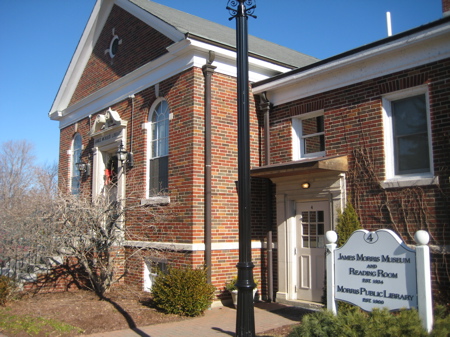
Go ahead – why don’t YOU think about that one for a minute.
Now, I really have no comprehensive answer for that fake question, but now that you’ve thought about it for a minute, you’ve come to realize there really aren’t too many which would qualify. Sharon and Kent are names of people, but I think we can agree they weren’t named after Nutmeggers. The only two that popped into my head (other than Morris, because I already know Morris is one) were Warren and Seymour. Hmm, now I’m hearing Goshen? Shelton? Who knows… Maybe the brilliant CTMQ commenting crew can think of some others that I don’t feel like looking up right now. (And no, Storrs and Collinsville and stuff like that don’t count as they are not real towns.)
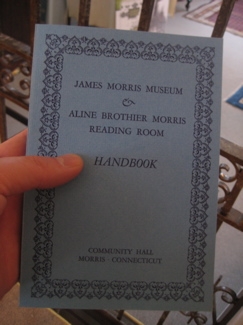
I can confirm that Seymour was named after former Connecticut Governor Thomas Seymour. So there you have it – at least two Connecticut towns were named after humans who lived in Connecticut. And the best part? James Morris was a pretty cool guy back in the Revolutionary days. Cool enough, obviously, to get a town named after him.
[2018 Update: While editing this page, I began to poke around. I quickly found that Griswold, Putnam, Chaplin, and Sterling qualify, and Shelton too, in a way. I didn’t go through the whole list of potentials, but I guess there are probably around 12 or 15 or so. Not all that exciting.]
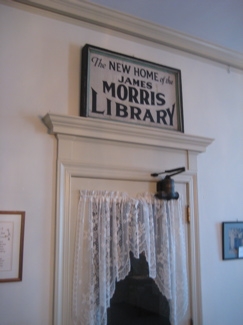
Granted, Morris is easily one of the least-known of our 169 towns. It’s rather inaccessible and put it this way: I only knew of it because of having to drive through it on my way to Bethlehem. That’s right, Morris is second fiddle to BETHLEHEM! Crazy, I know. (Hey Morrisites, don’t sweat it – I’m originally from Delaware. You know, the “I drove through it once and paid a toll on my way to another state” state.) But it does have a bunch of lakefront property on Bantam Lake and Winvian, the exclusive and unique overnight getaway for the affluent is hidden in northern Morris. (CTMQ visit here).
My stop here was sort of a backup plan. You see, down the road a piece in Bethlehem is the Regina Laudis Abbey. It’s an interesting little place in the woods for nuns and fans of nuns, but they also make cheese there. I’ve dragged my little family to their gift shop on three separate occasions and have yet to sample their otherworldly cheese. If and when I finally do get my hands on some of their cheese, I’ll be sure to describe the whole years-long saga in detail.
[2018 Update: Still haven’t had the nun cheese.]
But I’ve grown smart and brought with me the nuns’ phone number and called before heading down the road. No answer. “Oh look, baby!” I said to Hoang, “this totally and completely random parking lot I pulled into to make that unanswered call happens to be home to the James Morris Museum! Who knew?!”
Eye-roll.

The lot was completely empty except for one car but the museum was supposed to be open. Hoang gave me the go-ahead to check it out while she and Damian remained in the car. I fully expected the place to be locked up, but I sauntered right in the back door and into the basement of this multipurpose town hall/library/museum brick building that totally smelled like my grandparents’ church.
Up the steps, past the Comptroller’s office, past the tax assessor to the library (aren’t small towns cute?) and – locked! Dang! However, I could see a woman across the room in some sort of mobility device, but didn’t want to disturb her from her … her whatever she was doing. So I went back downstairs, through the basement/kitchen/square dance hall/voting station (aren’t small towns cute?) and then up the other stairwell on the other side, and up to the library at the far end.
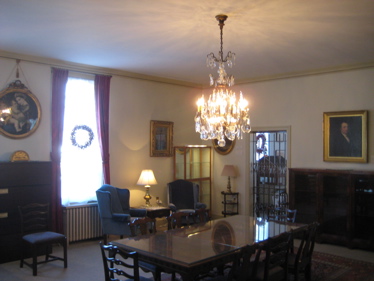
And… Voila! I was in! I saw the woman I’d seen previously and she was joined by another and they were amiably chatting away. They paused to say hello and smile and I was free to roam the James Morris Museum and Aline Brothier Morris Reading Room! All 30 square feet of it! Woo-hoo! (Aren’t small towns cute?)
Okay, yes, this place is tiny and before delving into why it even exists in the first place, it’s easy to dismiss it. And admittedly, I sort of did during my rather quick visit – hey, I did have two people waiting on me in the car after all. But let me, the guy who has been to 151 museums around Connecticut as of this writing, tell you that James Morris is a very interesting character and a stop in to his museum is worth the 10-15 minutes of your life. Heck, you’re in MORRIS! What ELSE are you gonna do?!
(I suppose you could hit the Morris Historical Society Museum 300 yards to the south which I’ll wager is pretty much all about James Morris anyway. And this is why I love CTMQ. There are TWO museums in Morris, within sight of each other. Awesome.)
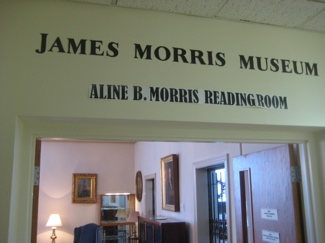
Once in the museum, I looked around to gather my bearings and to figure out the best plan of attack. Turns out, it doesn’t really matter. The Morris Museum is just one rectangular room with a table, some chairs, a bookshelf, some paintings and that’s pretty much that. The room next to it is the Aline Brothier Morris Reading Room, but it was blocked off to pedestrian traffic. That room contained a table, some chairs, a bookshelf, some paintings and yup – that was pretty much that.
So I inspected everything closely for a few minutes, snapped my pictures and just as I was about to leave with a slightly hollow, slightly enthused feeling I happened to notice a stack of little blue booklets under the portrait of James Morris.
Aha! All my questions answered! And it was free for the taking! I now felt complete, took one last look around and bound back out to the car and my beautiful waiting wife and child.
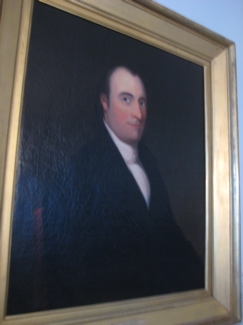
Okay, so I didn’t really learn anything at the museum proper, but that little blue book told me all I’ve ever needed to know about James Morris. Why was he so interesting to me? Because he seemed to hang out with a bunch of Revolution era people we’ve all heard of and know about – but he pretty much slipped through the cracks. But he has a museum in a town named after him! In Connecticut! So he’s worth our time… At least enough for me to cut and paste a bunch of stuff from Wikipedia – which I’ve cross-referenced with the booklet I picked up at the museum. (Seriously, I did.)
James Morris was born to Deacon James Morris Jr. and Phebe Barns Morris in South Farms, Connecticut on January 19, 1752.
Even as a young man, Morris displayed a disposition for education, borrowing often from the library in nearby Bethlehem, where his father was a member. Through these studies, Morris hoped to eventually become a minister. When Morris was eighteen, his father sent him to live full time in Bethlehem and study under Dr. Joseph Bellamy. Ah yes, he of the first theological school in the United States fame (CTMQ report here). Bellamy’s house is also now a museum, by the way.
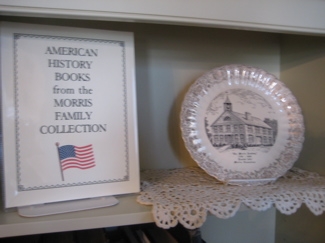
Morris continued with Bellamy until the spring of 1770, when he spent the season studying under the South Farms minister Dr. Salmon Hurlburt. That fall Morris found yet another instructor in some guy named Nathan Hale. Really?! Hale’s house is ALSO a museum as are two of the schoolhouses in which he taught! Morris said of him, “Mr. Hale was an accurate scholar and an able instructor.”
In September of 1771, Morris began more formal studies at Yale College. For his tutor at Yale, Morris was assigned future Yale president Timothy Dwight IV, who would be an influential force in coeducation in his own right. Eh, no museum for Dwight, but Yale named Timothy Dwight College for him, so I guess that’s something.
Upon graduation Morris returned to South Farms, where he helped his father with the harvest and took a post teaching grammar school in nearby Litchfield, where he received his first opportunity to teach and was paid “‘handsome wages’ hoping to reimburse his father for the heavy expenses of his college education.
Morris’s tenure as an instructor in Litchfield was cut short when, within months of arriving, he received an unsolicited ensign’s commission in the Connecticut militia, which he accepted. While in the service of the Connecticut militia Morris saw his first action, fighting battles in both Long Island and White Plains. In his memoirs, Morris wrote of this time, stating that “The soldiers universally manifested a great respect for me, for my care of the sick and my attention to their wants, and for my sympathies in their distresses.”
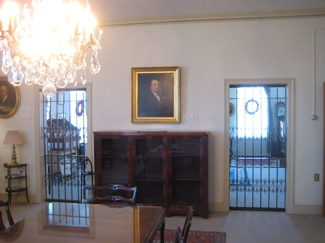
In late December of 1776, Morris completed his commitment to the Connecticut militia and immediately accepted a commission in the Continental Army as a first lieutenant After serving as a recruiting officer in Litchfield, Morris joined General George Washington and the army at Peekskill. On October 3, 1776, General Washington commanded this army in the Battle of Germantown. The American forces were ultimately unsuccessful in this battle and Morris was taken as a prisoner of war on October 4, 1776.
But Morris hung out with George Washington. Being a POW is a small price to pay for that honor.
The early part of Morris’s confinement were the most trying. He was taken to the “New Jail” in Philadelphia where he “was locked in a cold room … destitute of everything by cold stone walls and bare floors—no kind of a seat to sit on—all total darkness, no water to drink or a morsel to eat; without a blanket to cover him.
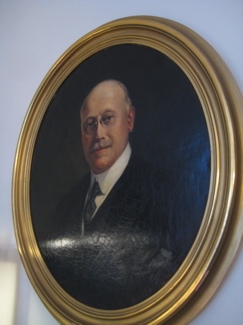
On January 3, 1781, Morris was freed as part of a prisoner exchange.
Upon his release, Morris returned to Peekskill where he discovered that he had been promoted to the rank of captain while in the custody of the British. Morris commanded a company back to White Plains until he received orders to head south to Virginia. Upon arrival, Morris’s company, under the overall command of General George Washington, aided in the Siege of Yorktown, the last major battle of the American Revolution. Specifically, Morris’s company of light infantry provided support to the forlorn hope commanded by Colonel Alexander Hamilton.
Again with the famous people!
James Morris returned to South Farms in December 1781. Days after his return, on December 20, he married Elizabeth Hubbard. Shortly thereafter, the people of South Farms made Morris both the Justice of the Peace and a Selectman. To this day, the town of Morris doesn’t have a mayor, but rather three Selectmen.
Read this next paragraph. It’s funny and creepy.
In the following years James and Elizabeth had five children and at one point, Morris became severely ill. During his illness, a man named Gad Farnam moved into the Morris’s home to care for him day and night. The two families became very close and Gad’s daughter Rhoda, only five years old at the time of the illness, later became Morris’s second wife. It was at this point in Morris’s life that he accepted that he would never realize his early dream of becoming a minister.
Haha, why? Because you married a girl you knew when she was FIVE?!
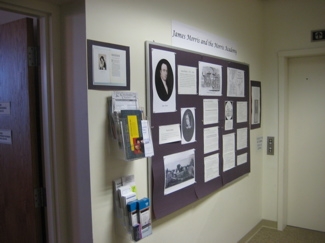
By 1790, it had become common for children to come to Morris’s house for instruction and access to his library. Morris welcomed all of these students, both male and female. Morris’s coeducation caused some stir within the community when some claimed that his education of women was “‘blowing up their pride’ so that ‘they would feel themselves above their mates and they would feel above labour.'” In 1794, these frustrations were brought to fruition when a hearing was held in the church. The charges were dismissed and the publicity from the controversy brought so much attention, that, by 1803, he had instructed students “from all the New England States except Rhode Island, and from the States of New York, New Jersey, Pennsylvania, Maryland, Virginia, South Carolina and Georgia. Also from the Island of St. Thomas in the West Indies, and from the Island of Bermuda.”
By the turn of the century, Morris found it necessary to formalize his instruction and construct a proper Academy building. The estimated cost was $1200, so Morris enlisted wealthy residents of Litchfield and South Farms.
On November 28, 1803, The Morris Academy moved out of James Morris’s home and into the brand new building. For the period from 1803 to 1812, the Morris Academy grew to an average of 50-75 students. The Academy was handed to several other heads of school, until, on April 12, 1888, the Morris Academy was closed for good.
In the introduction to her book on the academy, Barbara Nolen Strong noted:
The Morris Academy is entitled to be called a pioneer institution because of its ‘open door’ policy in coeducation. It was not the first in the United States, not even in Connecticut, but none of the other early academies opened their doors as wide and kept them open as long. No other coeducational academy spread its influence so far.
In September 1814 Morris’s wife Elizabeth died. The following March, Morris married Rhonda Farnam and the marriage bore two children, the last in November 1817. This cat was 65 years old! Having kids with a young woman in her 20’s! He sure does deserve a museum.
Toward the end of his life, Morris compiled his memoirs, which were subsequently published as Memoirs of James Morris of South Farms In Litchfield.
James Morris died on April 20, 1820 and it took almost 40 years to give the man his due. In June, 1859, South Farms was incorporated as Morris in his honor.
Which brings us to today and the little museum that contains original artifacts and writings of James Morris. The building was built in 1934 and formally presented to the town in an address by descendant Robert Clark Morris on January 19, 1935, the 183rd anniversary of the birth of James Morris.
And by the way, the foundation of The Morris Academy remains intact on the grounds of James Morris Elementary School, in Morris.
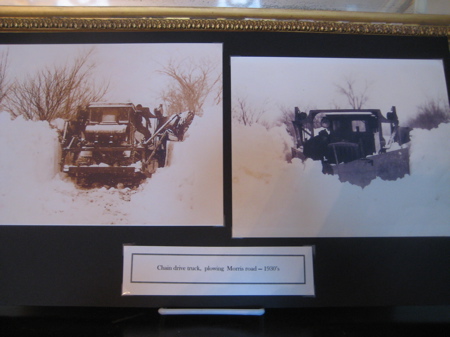
No website for the museum

 Jeff Hodlin says
Jeff Hodlin says
March 24, 2018 at 8:27 ammy name is Jeff Hodlin and I was wondering if you could send me a brochure on the James Morris Museum My address is 124 Sabins Dr. Southington CT. 06489. Thanks.